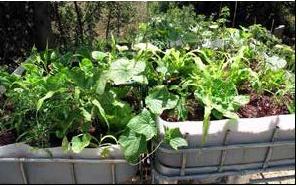6.6 PLANTING DESIGN
The layout of the grow beds helps to maximize plant production in the available space. Before planting, choose wisely which plants will be grown, bearing in mind the space needed for each plant and what the appropriate growing season is. A good practice for all garden design is to plan the layout of the grow beds on paper in order to have a better understanding of how everything will look. Important considerations are: plant diversity, companion plants and physical compatibility, nutrient demands, market demands, and ease of access. For example, taller crops (i.e. tomatoes) should be placed in the most accessible place within the media bed to make harvesting easier.
Encouraging plant diversity
In general, planting various crops and varieties provides a degree of security to the grower. All plants are susceptible to some kinds of disease or parasites. If only one crop is grown, the chance for a serious infestation or epidemic is higher. This can unbalance the system as a whole. As such, growers are encouraged to plant a diverse range of vegetables in small-scale units (Figure 6.12).
Staggered planting
As mentioned previously, it is important to stagger planting. In this way there can be

FIGURE 6.12
Example of two media beds growing multiple types of vegetables
constant harvest and replanting, which helps to maintain a balanced level of nutrients in the unit. At the same time, it provides a steady supply of plants to the table or market. Keep in mind that some plants produce fruit or leaves that can be harvested continually throughout a season, such as salad leaf varieties, basil, coriander and tomatoes, whereas some other crops are harvested whole, such as kohlrabi, lettuce, carrots. To achieve staggered planting there should always be a ready supply of seedlings (the development of a plant nursery is discussed in Chapter 8).
Maximizing space in media beds
Not only should the surface area be planned out to maximize space, but also the vertical space and time should be considered. For example, in regard to time, plant vegetables with short grow-out periods (salad greens) between plants with longer-term crops (eggplant). The benefit of this practice is that the salad greens can be harvested first and provide more room as the eggplants mature. Continued replanting of tender vegetables such as lettuce in between large fruiting plants provides naturally shaded conditions.
Make sure that the shaded crops are not completely dominated as the large crops mature. Vegetables such as cucumbers are natural climbers that can be trained to grow up or down and away from the beds. Use wooden stakes and/or string to help support the climbing vegetables. This creates more space in the media bed (Figure 6.13). One of the benefits of aquaponics is that plants can be easily moved by gently freeing the roots from the growing media and placing the plant in a different spot.

FIGURE 6.13
Examples of maximizing space in media beds using vining crops (a) and staggered planting (b)